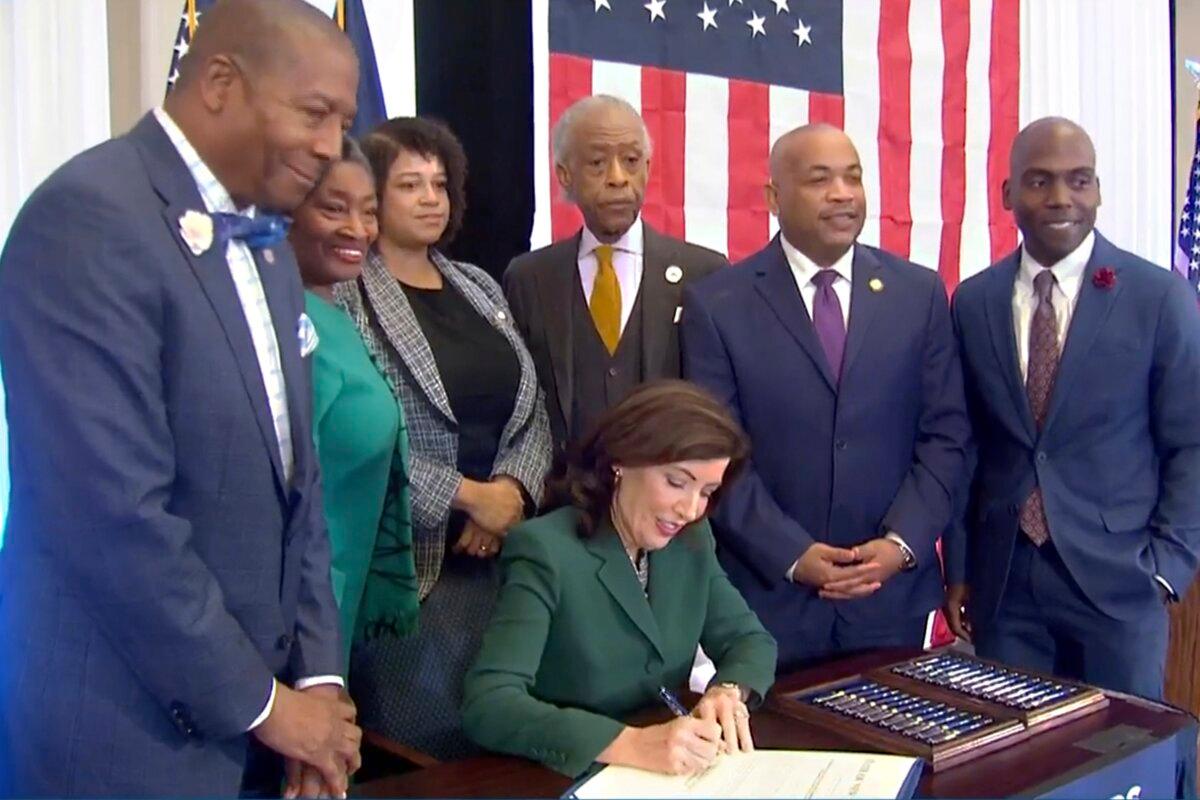No one knows if supermajority Democrat Legislature will endorse independent House plan when it convenes on Feb. 26, but pressure is on to remap a deeper blue.
All eyes will be on Albany Feb. 26 where New York lawmakers will vote to adopt or reject a proposed congressional map drawn by an independent commission that some Democrats maintain fails to address the alleged inequities they challenged in court to induce the revision.
If the supermajority Democrat-led New York Legislature accepts the map, Republicans could see diminished reelection odds for at least one of four House seats they flipped in 2022, key wins that helped the GOP regain control of the House.
If lawmakers reject it, by some estimates, Democrats could rig the state’s 26 congressional districts in a way that turns their 16–10 New York congressional delegation advantage into a 22–4 blue wedge.
New York lawmakers are also under pressure from national Democrat organizations to “match” what North Carolina legislators did.
After the North Carolina Supreme Court rejected the state’s 2022 maps, the GOP-dominant North Carolina Legislature redrew a map analysts say imperils three House Democrats and could turn the state’s 7–7 congressional delegation into a 10–4, or even 11–3, deep red contingent.
But no one really knows what will happen when New York lawmakers return from recess next week.
“Exactly,” Stop New York Corruption’s Rob Ryan told The Epoch Times. “Right now, we’re sort of in a waiting mode.”
“Democrats have put out statements where they want to get greedy” and rig the map to “match” North Carolina’s gerrymander, McLaughlin & Associates campaign consultant John McLaughlin told The Epoch Times.
“They’ve made some statements that the maps are not fair to people of color,” he said. “They’re looking for pretenses to make the map more Democrat.”
New York Democrats celebrated December’s Court of Appeals ruling that ordered a redraft of 2022’s congressional map that saw Republicans turn a 19–8 Democrat House delegation into one they only led 15–11.
Their target: Six freshman GOP House reps who won 2022 elections in districts President Joe Biden took in 2020, among seven 2024 New York House races The Cook Political Report rate as “toss ups” or “lean Democratic.”
One, former Rep. George Santos, is already gone. His 2022 flip was reversed when Rep. Tom Suozzi (D-N.Y.) won a Feb. 13 special election to claim Long Island’s Congressional District 3 (CD 3) seat.
CD 3 was among two, possibly six, of the 11—now 10—districts occupied by Republicans that Democrats envisioned remapping after December’s ruling.
But the draft released Feb. 15 by the 10-member, split-partisan New York State Independent Redistricting Commission (IRC) only moderately tweaks 2022’s map, stunning Democrats and relieving Republicans.

A Step Forward, ‘A Step Back’
New York Democrat leaders were non-committal when the draft was posted, vowing to ensure it complies with federal and state guidelines.
“We owe it to the public to carefully review these maps, especially in light of serious concerns being raised by various communities of interest,” New York State Democratic Party Chair Jay Jacobs said in a statement
Some Democrat lawmakers angrily called for tossing it, indicating it will be difficult to secure a 75-percent majority vote to affirm the IRC’s map.
“These maps are a disgrace and ought to be rejected by the legislature,” state Sen. James Skoufis said in a statement.
Republicans called on lawmakers to adopt the map.
“The voting public deserves to have continuity in district boundaries and to avoid chaos,” New York Republican Chair Ed Cox said in a statement.
National Republican Redistricting Trust President and Executive Director Adam Kincaid said in a statement the map is “a step back” from 2022 but called on lawmakers to adopt it so campaigns can focus on June primaries.
“Most New Yorkers like the idea of competitive elections and like congressional districts drawn accurately to reflect populations, which would make them quite competitive, so they can hold their congressmen accountable,” Mr. McLaughlin said.
“New Yorkers don’t want to have lop-sided, one-party districts,” he added.

‘Pretenses’ to ’Get Greedy’
The Democratic Congressional Campaign Committee, which invested millions and deployed top elections lawyer Marc Elias to litigate the suit, as well as national Democrat leaders such as House Minority Leader Rep. Hakeem Jeffries (D-N.Y.), are pressuring New York lawmakers to draft their own map.
Although rejecting the map is certain to draw lawsuits and entangle the process in litigation for the third time in three years, Democrats nevertheless appear to have found “pretenses” to “get greedy.”
Mr. Jeffries’ office maintains the IRC violated the state constitution by redrawing maps that benefit incumbents and divides “communities of interest.”
“The IRC map breaks apart six additional counties in New York, including one that appears gratuitously designed to impermissibly benefit an incumbent in the 19th Congressional District,” Mr. Jeffries’s spokesman Andy Eichar said, referring to the district flipped by first-term Rep. Marc Molinaro (R-N.Y.) in 2022.
While defining how “communities of interest” are being divided in CD 19 is subjective, claims the map benefits incumbents are more substantive.
In 2022, eight of New York’s 26 House members won despite not living in redrawn districts. While two—Mr. Molinaro and Rep. Claudia Tenney (R-N.Y)—have moved into their districts, six have not.
The IRC’s modifications don’t dramatically alter the map, but they move three incumbents’ homes into districts they represent. Among the two Democrats is none other than Mr. Jeffries, whose Prospect Heights home is in the CD 8 he represents under the IRC’s map.
Residency issues are quibbles but, Mr. McLaughlin said, he would not be surprised if Democrats cite them as excuses for redrawing the map.
“The Democrats here are relentless,” he said, noting he expects Mr. Elias to “again lead the charge to disregard the state constitution and the previous recommendations of the redistricting commission.”

The IRC’s Map
Of seven New York congressional districts rated by The Cook Political Reports as “toss ups” or slight partisan tilts, three are on Long Island and three are in the Hudson Valley. The other, CD 22, is a Syracuse-area district in central New York.
According to The Cook Political Reports, the proposed map is “redder” for Mr. Molinaro in CD 19 and “bluer” for Rep. Pat Ryan (D-N.Y.) in CD 18 in the Hudson Valley, and “bluer” for Rep. Joe Morelle (D-N.Y.) in Rochester-area CD 25.
The only Republican whose reelection odds are degraded is Rep. Brandon Williams (R-N.Y.) in CD 22, which the map stretches west to include Auburn and other areas likely to benefit Democrat challenger state Sen. John Mannion.
By The Cook Political Reports Senior Editor Dave Wasserman’s “initial math,” under the IRC’s map, CD 22 would grow from a district Mr. Biden won by 7 percent in 2020 to 11 percent; Mr. Ryan’s CD 18 would go from Biden +7 to Biden +11, and Mr. Molinaro’s CD 18 go to Biden +1, down from Biden +5.
The IRC’s map leaves several key contested districts largely intact, he said.
“It seems it got better for Molinaro and for Ryan at the expense of Allison Esposito,” the CD 18 Republican challenging Mr. Ryan, Mr. McLaughlin said.
Three GOP freshman elected in 2022 in districts President Biden won in 2020 won’t see significant changes: Rep. Mike Lawler (R-N.Y.), who won CD 17 by less than 1 percent; Rep. Nick LaLota (R-N.Y.) in CD 1; and Rep. Anthony Esposito (R-N.Y.) in CD 4.
“I feel very good about where we are and the work we’re doing, and as long as it’s a fair map, I’m confident I’m going to win,” Mr. Lawler told The Epoch Times. “The question will be, what will they try to do on the map?”

‘Clock is Ticking’
If lawmakers adopt it and Democrat Gov. Kathy Hochul signs it into law, the map will be implemented for the June 25 primary and Nov. 5 general election.
But if lawmakers opt to craft their own map, timelines come into play, including a Feb. 27 primary filing deadline.
“At this point, lawmakers have several choices,” New York Law School professor and elections attorney Jeff Wice told The Epoch Times. “They can accept the commission map, send it to the governor for signing, and the process is over.”
If they do anything other than adopt it, “a lot of things have to happen quickly” because “the clock is ticking” for primary candidates to file, he said.
“Nothing prevents” lawmakers from changing the candidate petition schedule, reducing requirements such as number of signatures, or pushing the June 25 primary later into summer, Mr. Wice said.
Under state statute, lawmakers can amend up to 2 percent of the map—no more than 2 percent within any district—without triggering a full revamp.
Mr. Wice, with more than 40 years of New York redistricting legislation and litigation experience, said any 2 percent change here, means a 2 percent change there, and creates “a domino effect across the state.”
What lawmakers may do, he said, is “repeal that statute to eliminate the 2 percent question” to allow them to extend filing deadlines, lower qualifying thresholds, amend the map, get it to the governor, and be set for the June 25 primaries.
Mr. Wice said among issues to be determined in the inevitable onslaught of lawsuits would be which map—the 2022 iteration or the IRC’s 2024 revision—qualifies for the “Purcell Principle,” a federal doctrine that courts should not alter election rules in an election year.

Can’t ‘North Carolina’ New York
National Democrat organizations are demanding New York lawmakers do what North Carolina legislators did in adopting a blatantly gerrymandered map that overtly favors Republicans.
North Carolina’s new map skewers the state’s 14-district alignment that produced a 7–7 House delegation into one where Republicans are favored to win at least 10 seats.
Mr. Wice said federal law imposes population and other requirements in congressional districting but “there’s no federal standard for partisan gerrymandering.”
While New York’s constitution delegates district mapping to an independent commission prohibited from drawing lines that benefit or disadvantage incumbents, North Carolina has no such restriction.
With so many entanglements certain to follow a rejection and new map, Mr. Wice said lawmakers may simply accept the map and move on. “This could be over fairly quickly.”
But these are New York Democrats, Mr. McLaughlin said. It’s unlikely they’ll passively accept a map they successfully sued to change that does not make those changes.
“The Democrats have super majorities in the state Senate and assembly,“ he said. ”You’re looking at a situation where they don’t really care what the Constitution says.”
Original News Source Link – Epoch Times
Running For Office? Conservative Campaign Consulting – Election Day Strategies!


